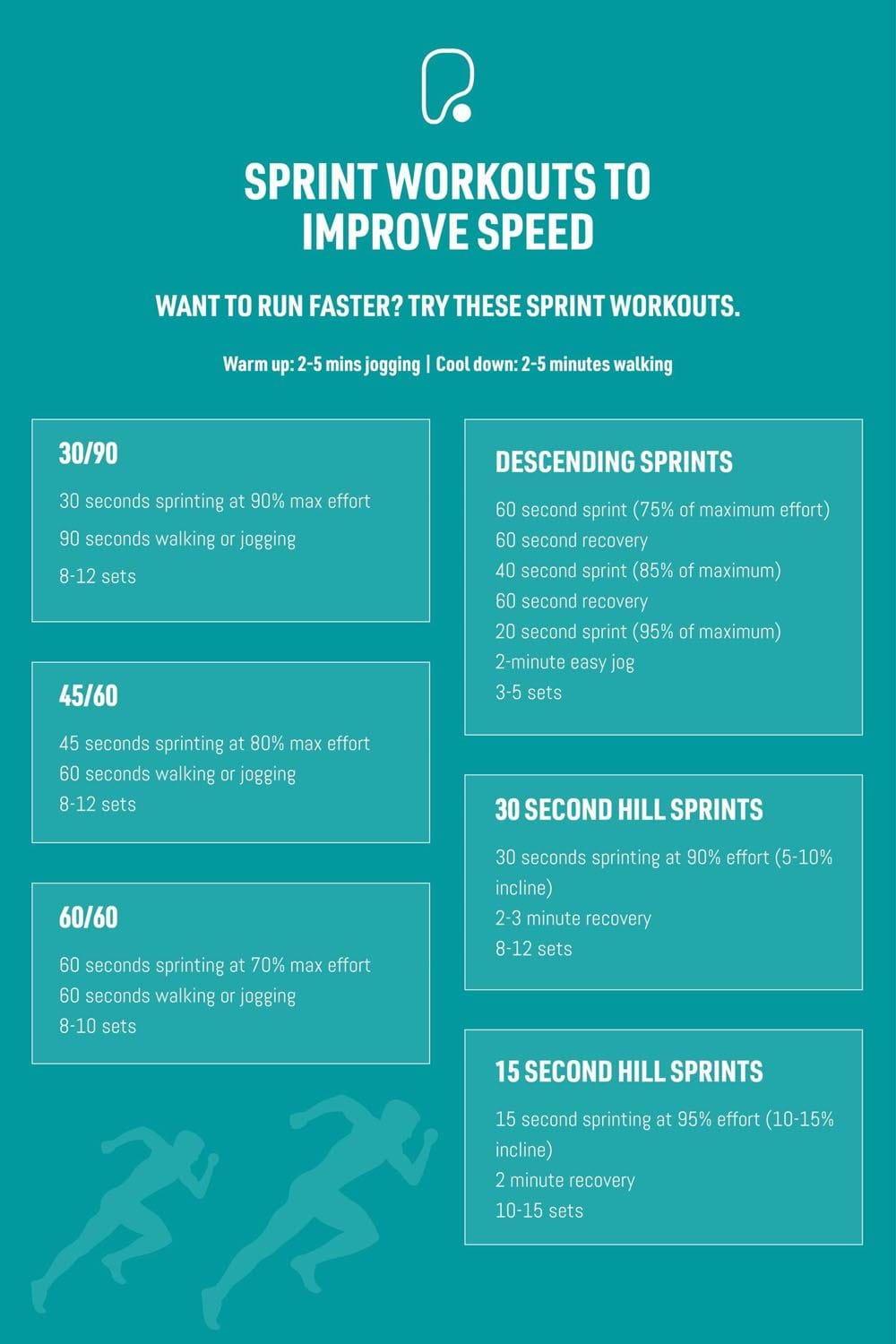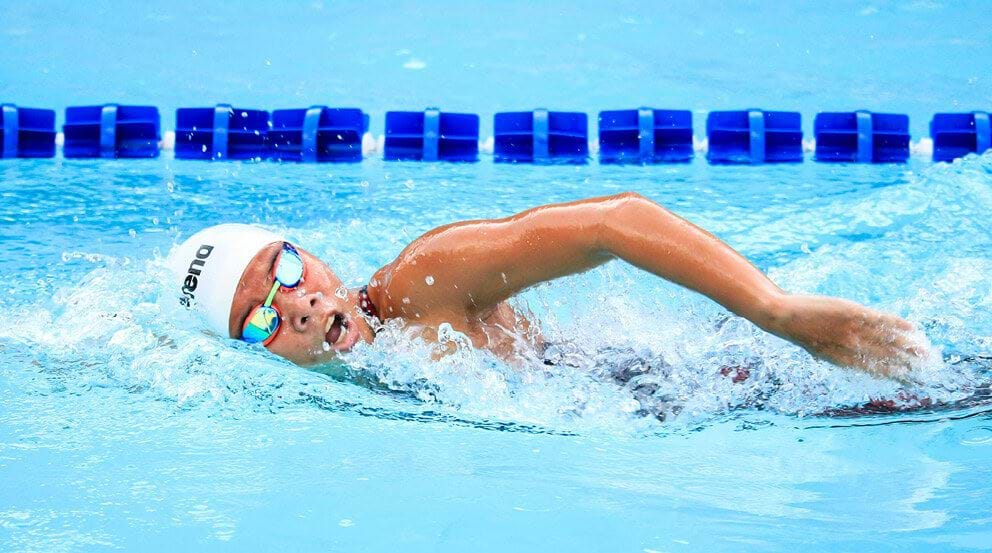5 of the Best Sprint Workouts to Improve Speed

Page last updated: 11th April 2023
Whether you're training for a marathon or simply enjoy a short run every now and then, every runner can benefit from adding sprint workouts to their training regime.
In this article, we'll look at what sprint workouts are, the benefits of sprint workouts, how often you should be doing them, and five of the best sprint workouts to incorporate into your routine.
Want to try out a sprint exercise for yourself? We've asked British Distance Athlete, Charlotte Arter, to share some of her favourite sprint workouts for speed training and why she thinks they're beneficial to all runners.
What are sprint workouts?
Sprinting involves running at your top speed for a short amount of time. Sprinting is an anaerobic exercise, exercise where the body cannot bring in enough oxygen quickly enough to provide energy for the movement. Instead, it uses glucose in the muscle to provide energy, which produces lactic acid. As lactic acid builds up in the blood, the body reaches lactate threshold, which means lactic acid is accumulating faster than it can be removed. This accumulation impacts the muscles’ ability to contract, which is why you are only able to sprint for a limited amount of time.
Sprint workouts combine short bursts of sprinting with recovery periods, which allows the body to produce enough oxygen to remove the lactic acid before a new sprint interval begins.
What are the benefits of sprint workouts?
Sprinting causes the body to reach their lactate threshold in a short amount of time, but long-distance runners can reach the lactate threshold too. By incorporating sprint exercises into your training, you cause your body to adapt to an increase in lactate acid, which pushes the threshold higher and means you can run for longer, or run faster, before reaching the threshold. Simply put, you can run faster and for longer!
In addition to improving the lactate threshold, sprinting increases your VO2 max, the amount of oxygen your body can take in while exercising at maximum effort. A higher VO2 max means more oxygen, which means a greater ability to remove lactic acid, which means it takes even longer to reach your lactate threshold. And, as oxygen is required to turn glucose into fuel for your muscles, it means more energy during your runs too. Taking all this into consideration, it's no wonder sprinting is seen as an incredible tool to improve your running!
Sprinting has also been shown to build muscle and strength in the legs, as long as it's paired with the right nutrition. Building muscle increases your endurance, which means you can run for longer before being fatigued, and can improve your speed. Don't rely just on sprints to build muscle, though -- you'll want to incorporate strength training too. Check out our free workouts if you aren't sure where to start!
We also asked Charlotte Arter what she finds beneficial about sprinting:
"Sprints can be a really effective way to improve your cardiovascular fitness, strength and power, and running economy. You can gain bigger improvements and in less time with sprinting than with continuous easy running! However, as sprinting is really high intensity you should only incorporate these workouts a couple of times a week to allow adequate recovery.
Sprint training can be done anywhere -- outside on pavements, in the park, on a treadmill, on flat ground and hilly ground. I'd recommend only doing sprint sessions on a treadmill if you have adequate experience of interval training on a treadmill, as it can be tricky to navigate versus running outside."
Sprint workouts to try
Want to train like a British distance athlete? Charlotte has shared some of the sprint training sessions she uses so you can:
“Sprinting is an explosive and high intensity training, so make sure you get a good warm up before you start your session and a cool down afterwards.
It is important to remember good technique when sprint training, as this will help improve your running economy and efficiency. Focus on high knee drive, heel under glute, and high arm carriage at 90 degrees. You should also keep a short, snappy stride, rather than reaching for your stride. On hill sprint workouts, look a couple of metres in front of you; when sprinting on the flat, focus on something at eye level in the distance.”
The following sprint workouts can be done both outdoors on tarmac or on the treadmill. For the treadmill, you’ll want to establish your sprint pace setting in mph beforehand. Once you know the setting, you can increase the speed, counting your sprint time from when you reach the right setting on the treadmill. After the sprint is up, slowly decrease the speed for the recovery period. You’ll need to start increasing your speed before the recovery time is up to allow for the full sprint."
There are many reasons you might want to try sprints on a treadmill, from bad weather outside to treadmills being lower impact than many outdoor surfaces. We’ve shared our favourite treadmill sprint workouts in this blog.

- 30 second sprint with 90 second recovery (90% of maximum effort)
This session involves running at "top speed" or as fast as you can while keeping good form, for 30 seconds, then 90 seconds recovery either walking or jogging.
Beginners should aim to do 10 rounds, working up to 20 rounds for an advanced workout.
If you're looking for a HIIT sprint workout, this is it! Not all sprint workouts will be considered HIIT, but those that are offer the same benefits that all HIIT workouts have, including burning fat even after the workout has finished, improving overall fitness and endurance, and being extremely time efficient (read more on the benefits of HIIT here).
If you are interested in trying out more HIIT sprint workouts, check out our blog on it.
- 45 second sprint with 60 second recovery (80% of maximum effort)
This workout involves sprinting at 80% of your maximum; you should be running at a fast but controlled pace. There is only 60 seconds recovery so make sure you walk or jog at a pace that allows you to recover enough to give it everything in the sprints.
Beginners should aim to do 8 reps, progressing gradually to 12 reps for an advanced session.
- 60 second sprint with 60 second recovery (70-75% of maximum effort)
A full minute of sprinting can feel like forever, so this workout is more of an endurance speed session than a maximum sprint workout. The sprint should be run at 70-75% of your maximum effort, and the 60 second recovery should be walked or jogged slowly enough that you can keep up the effort during the sprints.
For beginners, start around 8 reps and gradually progress to 10 reps. This session can also be extended for more advanced runners:
- 5 sets of 60 sec sprint, 60 second recovery
- 4 minutes easy run
- Repeat 3 times
- Descending sprint workout
This sprint session involves increasing the speed of your sprint as you descend down the set:
- 60 second sprint (75% of maximum effort)
- 60 second recovery
- 40 second sprint (85% of maximum)
- 60 second recovery
- 20 second sprint (95% of maximum)
- 2 minute easy jog
- Repeat 3-5 times
- Hill sprint
Hill sprints are a great option for sprint training. They help to improve speed, power and strength, as well as your biomechanics and running efficiency. If you haven't done any hill training before it is important to progress gradually, as it puts more stress on your body than sprinting on flat ground.
- 30 second hill sprints with a 2-3 minute recovery (90-95% maximum effort on a 5-10% incline)
30 seconds doesn't sound like enough to warrant a 2-3 minute recovery period but running uphill is tough! This can be done outside on pavement or on the treadmill. For outside hill sprints, run up the hill for 30 seconds and walking or jog back down it during the recovery
For the treadmill, stand on the sides of the treadmill and adjust the incline to 5-10%, adjust the speed, hop on and run. After the 30 seconds are up, hop back onto the treadmill, lower the incline and walk or jog the 2-3 minutes. Just before your recovery time is up, stand back on the edge of the treadmill, increase the incline and speed, and start your sprint set.
Beginners should aim for around 8 reps, progressing through to 10 reps for advanced.
- 15 second hill sprints with a 2 minute recovery (95% maximum effort on 10-15% incline)
This sprint workout involves going flat out for 15 seconds, before a 2 minute recovery walk or jog. The incline is steeper (10-15%) so you'll really need to focus on technique.
A beginner session will be around 10 reps, moving up to 15 reps for advanced.
Incorporating different sprint workouts into your training will certainly help to ramp up your fitness and increase your speed and endurance! It's important to use these workouts as a guide -- make sure you alter them depending on your fitness level and running experience, and increase the number of sprint sessions gradually, keeping them at no more than twice a week to ensure your body can recover properly.
If you're worried about starting a new regime, why not work with a Personal Trainer at PureGym?


